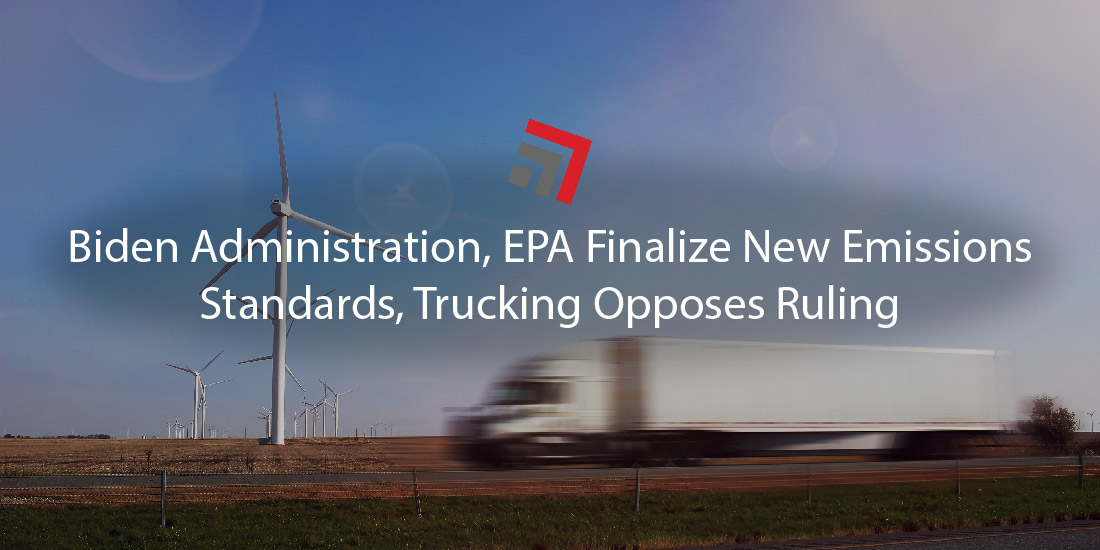In what a group of trucking stakeholders claim will cost $1 trillion, the U.S. Environmental Protection Agency (EPA) has finalized new emissions rules for heavy-duty trucks. The regulatory action introduces an accelerated timeline that obliges manufacturers to incrementally sell more zero-emission vehicles in the coming years.
Trucking stakeholders view the President Biden-led EPA’s ruling as a challenge to trucking’s operational fortitude, arguing that the mandate is too aggressive and unrealistic.
As it stands, a percentage of each manufacturer’s total vehicle sales must be converted to zero-emission vehicles every year. By 2032, the rule eyes for 25 percent of new long-haul and 40 percent of short-haul (and medium-duty) vehicles to be zero-emission.
Trucking stakeholders oppose final ruling
The EPA announced the final ruling on Mar. 29. Titled “Greenhouse Gas Emissions Standards for Heavy-Duty Vehicles – Phase 3”, the rule sets stronger standards to reduce emissions from trucks beginning in model year 2027.
The final “Phase 3” standards build on the federal agency’s 2016 heavy-duty phase two program.
Trade group American Trucking Associations (ATA), an outspoken opponent of the rule, promptly published a press release following the Biden Administration’s announcement.
“ATA opposes this rule in its current form because the post-2030 targets remain entirely unachievable given the current state of zero-emission technology, the lack of charging infrastructure and restrictions on the power grid,” said ATA President and CEO Chris Spear.
Spear’s scathing critique falls in line with other stakeholders’ opinions. They assert that the regulation fails to account for the operational realities of the trucking industry, claiming the country’s supply chain is being set up for failure.
As mentioned earlier, an alliance of trucking groups, including ATA, claimed the overall investment needed to electrify their fleets and satisfy increased charging demand on the U.S. power grid will amount to nearly $1 trillion, a cost that they argue the industry cannot afford. They support this claim via a study they commissioned earlier this year.
Another industry influencer, the Owner-Operator Independent Drivers Association (OOIDA), has raised concerns over the rule regarding costs, safety, and operational problems. As an advocacy group for small-business and self-employed truck drivers, OOIDA warns that the accelerated mandate enforces higher purchase prices and operating costs with newer vehicles. Facing newfound expenses, the group argues that drivers will be financially forced to remain operating their older trucks.
The upfront purchase of a battery-electric truck is considerably higher than a conventional diesel build. The base price of a Class 8 (heavy-duty) battery electric truck is between $350,000 to $500,000—around three to five times that of a diesel.
OOIDA went on to add that drivers are skeptical of the newer technology, uneasy about making such a hefty investment when several question marks still exist about battery-electric capability. Among them are maintenance costs, mileage range, and charging time.
Federal regulators laud rule
Attached in its Mar. 29 announcement of the finalized rule, the EPA responded to the many comments posted by concerned stakeholders.
Overall, the federal agency has justified the rule as an essential agent towards reducing emissions, protecting public health, and catalyzing investment in capacity for zero-emission technologies.
“EPA’s standards complement President Biden’s unprecedented investment in our workers and communities to reduce harmful emissions, while strengthening our manufacturing capacity for the transportation technologies of the future,” said President Biden’s National Climate Advisor Ali Zaidi said.
The EPA states that the standards will avoid 1 billion tons of emissions and provide $13 billion in annualized net benefits to society related to public health, the climate, and counter to what OOIDA forecasts, savings for truck owners and operators.
The final standards are less strict then initially proposed, which has upset both environmental advocates and zero-emissions industry groups.
Final Thoughts
Aside from commercial trucks, the standards will also apply to other heavy-duty vehicles, including public utility trucks, passenger buses, and garbage haulers.
Contact one of our team members if you have any questions regarding this topic or any others in domestic logistics.
More blogs similar to this:



Recent Comments